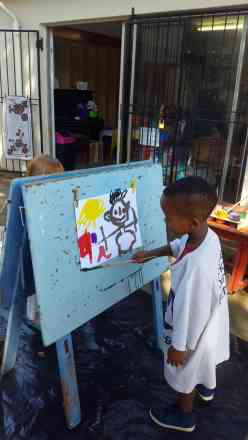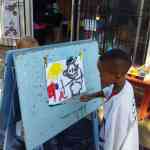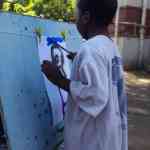WHAT A MESS? Nope....
Aside from the activity being fun, and allowing a child to release emotion and express themselves, R. Althouse, M.H Johnson & S.T Mitchell from the New Jersey Department of Education found through a study that there are many other benefits to easel painting in the pre-school environment.
Art easels are necessary in the preschool classroom. Visual art deeply affects our lives – it is one of the most important forms of communication. Imagine a world without color, pattern, line, texture, space, and proportion. Easel painting provides opportunities for children to experiment with these aesthetic elements. It also provides an avenue for teachers to scaffold rich experiences that encourage emotional, physical and cognitive growth (language, math, and science). Easel painting can provide a descriptive language of how a child is developing emotionally, physically and cognitively. Most of all it is fun, joyful, creative, and exciting – it brings richness and depth to a program.
Painting at the easel has a fluidity that is different from other art media that children use. It is first and foremost a sensory experience. When learning about paint children will learn how to move from a brush stroke that exhibits wild abandon to a more controlled, refined movement. During the process of learning to work with paint, children will develop:
- Socially/Emotionally by working together at a double or four sided easel. Preschool artists share conversation, techniques and methods using the vocabulary of art language. Also, children are being trusted to control a very messy activity. (Expressive language, Intrapersonal, Interpersonal).
- Physically, by using the large and small muscles of the arm. Children’s development follows a general pattern from large to small muscle. And, as children exercise their large and small muscles, they also improve their eye-hand coordination. (Physical, Kinesthetic).
- Cognitively, by constant problem solving challenges at different ability levels – at first – how do I get the paint to the paper, how do I keep the paint on the brush, how do I keep the paint on the paper, how can I stop the paint from dripping, how do I make this color, - and later – how do I make this line, how do I make this shape, how can I get these shapes and lines to make the picture I want, etc. (Spatial, Math, Science).








